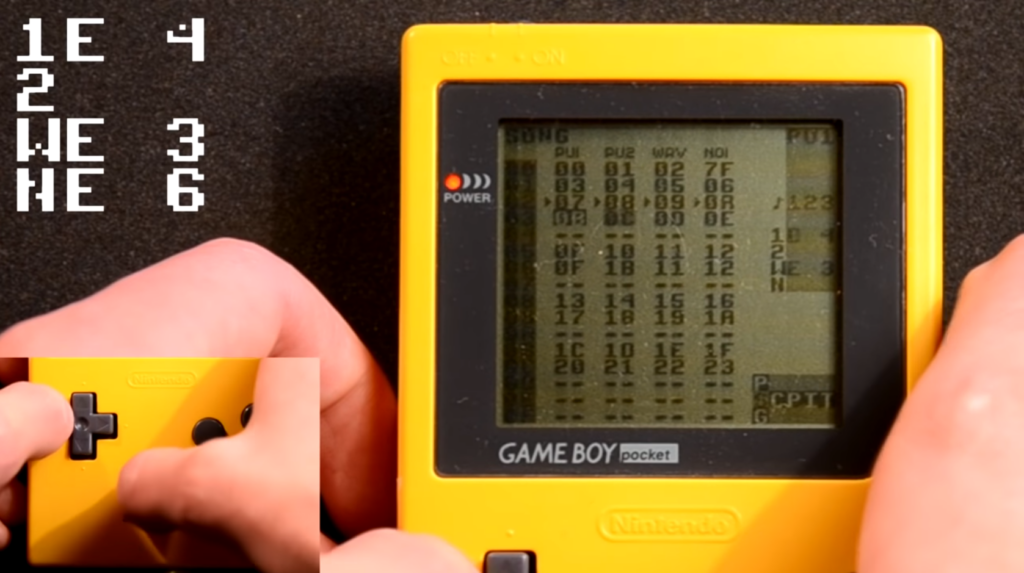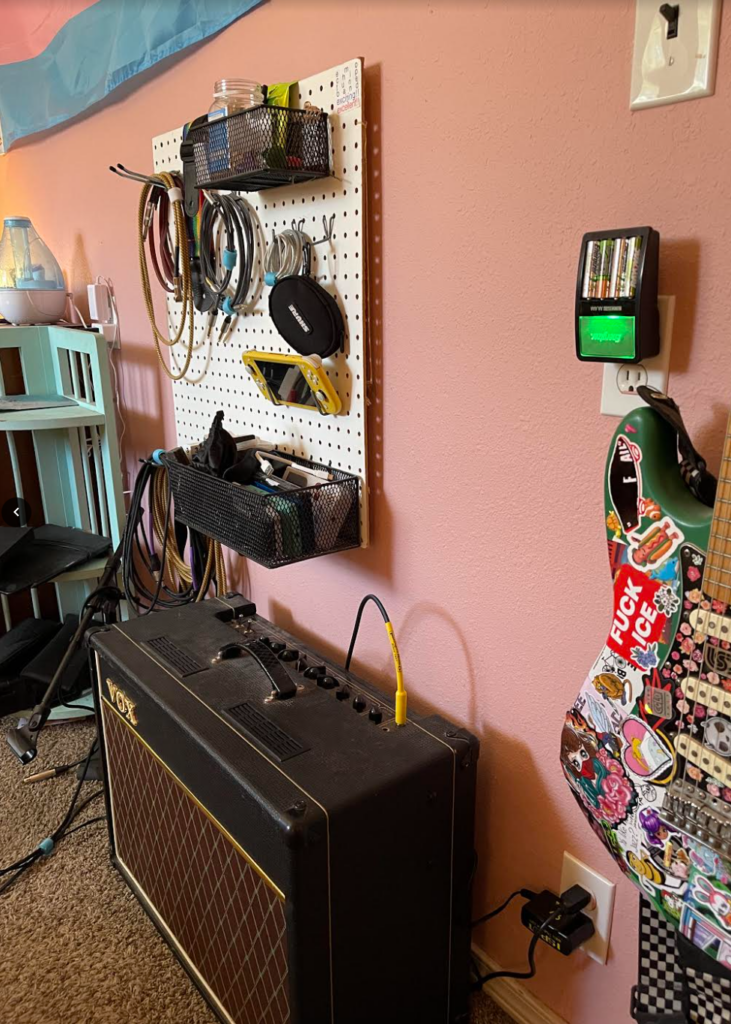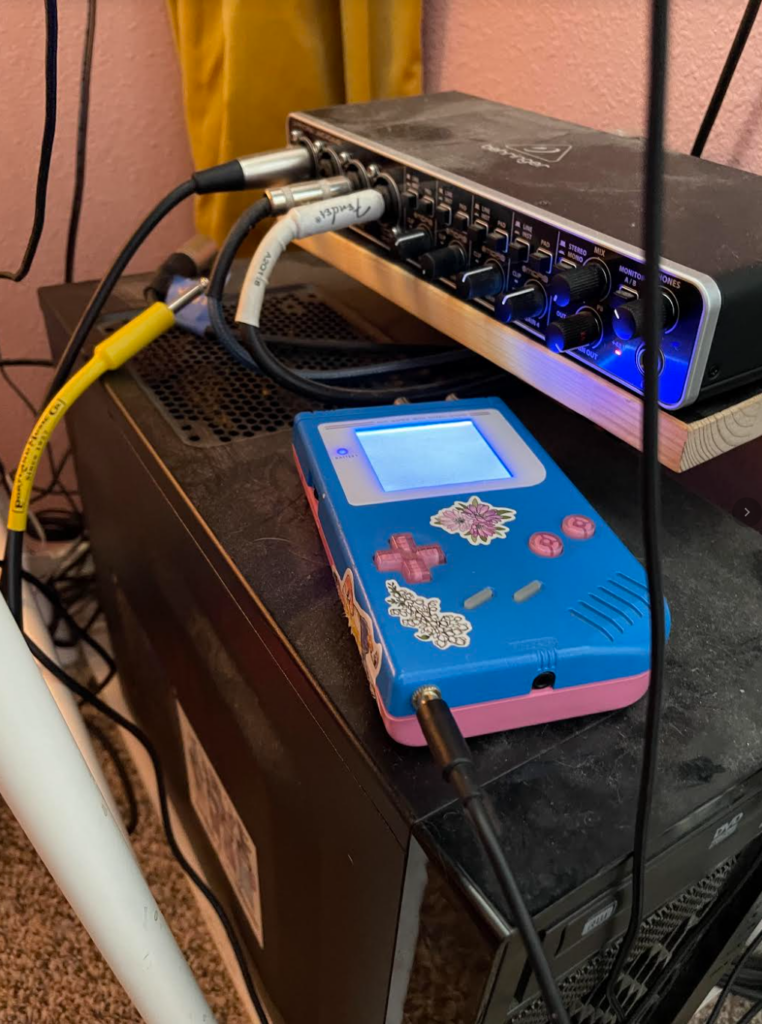Chiptune might actually be the most punk shit ever. Like, seriously – it’s as DIY as it gets. Jasmine McElroy makes music as exciting!!excellent!!, a one-woman, one-Game Boy show, crafting a uniquely nostalgic sound by blending the iconic bleepboops of retro gaming with sentimental midwest emo.
After listening to her latest EP tysm!!!!!! and chatting with her about the world of mods and trackers, I’m convinced that her brand of chiptune emo is the future. But don’t just take my word on how cool it is, hear it from the chiptune emo queen herself!
How long have you been making chiptune music?
E!!E!!: I started in 2018. I was in a pop punk band before, just a small local thing. And that band was breaking up. I was looking to do something new, but I didn’t want to have to rely on bandmates this time, because bandmates have kids and jobs and all that boring shit. And Game Boy doesn’t have any of those problems!
I was already into Crying at the time, but then I found (T-T)b as well. Both very cool bands that were doing full band stuff, just with chiptune added in there. I thought it was a really cool sound. I had another solo project for a minute where I was just doing acoustic guitar and Game Boy, and it was supposed to be a little bit more lo-fi, but over time I started writing more and more complex songs and that was when I got the idea for exciting!!excellent!!, which started in 2020.
When you say Game Boy, this is like the OG ’89 Game Boy, right?
E!!E!!: Yeah, we call it the DMG001. You can use other models like the Pocket or the Color, though. I’ve seen people do stuff with SPs and Advances, too. They all have slightly different sound chips, but the original one, in my opinion, you can’t beat it. There’s this intangible warmness to the tones compared to the more modern iterations of the Game Boy. I’ll only ever use the original Game Boy.
So you write songs directly on the Game Boy, you don’t use an emulator?
E!!E!!: Sometimes I’ll write it on an emulator and transfer it to the Game Boy. But these days I’ve actually been writing directly on the Game Boy. I use a program called Little Sound DJ or LSDJ, which is a tracker program that a lot of chiptune artists use who work with Game Boy. I find it a lot more intuitive to use than a lot of modern DAWs. So, first I write the song on guitar and vocals, and then as far as the Game Boy stuff goes, I’ll program all of that at once and then I’ll record each individual track into my DAW, which in this case is Reaper.

How exactly does one go about composing a song for the Game Boy, as opposed to an arrangement meant for a piano or a guitar?
E!!E!!: Well, what’s neat about using the Game Boy sound chip specifically is that you’re very limited in what you can do. There’re only four channels on the sound chip: two of them produce pulse waves, one of them is a wave channel, one is a white noise channel and that’s it. But it forces me to be really creative since I can’t just sit there and go super crazy. I’m trying to fit everything into a predefined box that I can’t leave… unless I wanted to add another Game Boy, which I might someday.
As far as doing chords and stuff, there’s a chord command in the tracker I use. All it does is it very quickly arpeggiates the notes in the chord for the parameters you give it and it’ll do that iconic chirp sound that people associate with Game Boy.
It’s funny because I know this isn’t what it looks like, but when you talk about composing the music through the plug-in, I keep picturing it as the Mario Paint game.
E!!E!!: Yeah, people do some sick ass stuff in Mario Paint though, that is a whole genre upon itself! But no, the interface for LSDJ is a lot less cute. It’s pretty much just a lot of letters and numbers. Tracker programs are pretty notoriously clunky looking. They’ve been around since like, the Amiga computer system was a thing and people were passing around software cracks and stuff. And the big thing was that there was always this sick ass music that would play whenever you loaded it up.
All that is a little bit before my time, but when I was growing up, a lot of the crack software would also have really sick chiptune songs. I was like, “Why is it that when I’m just clicking the thing to get a serial number it has this ripping chiptune solo going in the background while I’m doing it?” There’s a whole culture behind this. And they would use trackers basically just telling the computer “NOTE ON, NOTE OFF.” A kind of command driven music as opposed to like, a piano roll you would see in a DAW.
That’s so cool. I’m not super familiar with trackers, is it something you have to write out code for?
E!!E!!: Not quite. I mean, there are commands you’re inputting and stuff, but it’s all kind of laid out in a little grid. You’re not like, typing lines of code. But you are programming it in a sense. You’re setting up instructions for the computer to follow later. That’s programming.
Is getting the hardware updates or pre-modded stuff expensive?
E!!E!!: It’s not super expensive. It was just like, definitely out of my skill set to do at the time so I bought one that was pre-modded. But it’s not really that complicated. Doing it on the original Game Boy…I mean, it’s small in there, but it’s not too cramped. That’s one of the reasons people like the original one, too, because it’s got a lot of room in that case.
And it’s four AA batteries, so you rarely have power issues like you do with the others. There are mod kits you can get to replace the battery kit with a lithium ion. You can get a little USB charging cable for it and boom, rechargeable Game Boy! But now, we’re getting into the electrical weeds of it and that is not my expertise. I just write the songs, I get other nerds to do that shit for me. [laughs]


What are some resources for people interested in modding devices for chiptune?
E!!E!!: BennVenn is one modding site. Catskull is another very good retro modding shop. They all sell kits and stuff for this kind of thing. Like, for the ProSound mod, you’ll order a kit and they’ll send you a little jack and everything that you need to hook in there. Then literally all you have to do is drill a little hole in the case and solder it in. It’s pretty low impact and the kit itself is only like a dollar because it’s just little components.
This is actually a lot more accessible than I imagined.
E!!E!!: It is surprisingly accessible. That’s kind of why I’m a little evangelist for chiptune because…ain’t nothing more punk than this! You’re taking an old children’s toy and you’re making music on it and it costs very little to do. The most expensive part of it is probably going to be getting your flash cart. I use one called El Cheapo, which is from BennVenn. I like that one because for one, it is very power efficient. Two, it has an SD card instead of having to connect it to my computer with a cable.
Are there any video game soundtracks that you really enjoy?
E!!E!!: As far as chiptune soundtracks, obviously the original Pokémon games are way up there. The Lavender Town theme goes way hard. I like bringing up Pokémon when talking about chiptune because it’s a really good demonstration of how limited the sound chip is in the Game Boy. When you’re fighting another Pokémon and yours is really low health, you hear part of the song cutting out when that’s happening. That’s because all the sound channels are busy playing the song, so it needs to cut one of them to annoy you with the “ding ding.”
The first video game I ever played where I really was obsessed with the music, though, wasn’t even chiptune music. It was Banjo-Kazooie. The second track on my EP references the game! That was the first game that I played where I was like, “whoa!” Like, you go to the snow level and everything turns into, like, twinkly bells and then you go underwater and it changes again. It’s really cool. I was like, “how are they doing that?” And it’s these MIDI instruments, and it’s just swapping out notes as you go from area to area.
Wait, which part is a Banjo-Kazooie reference? I listened and totally missed it!
E!!E!!: “Ice Key!” It’s subtle, but the reason it’s a Banjo-Kazooie reference is because when you beat the game, there’s a post credit sequence where they show you all these items you can go find now and it was called “Stop ‘n’ Swop.” It was a bunch of items and one of them was an ice key.
They were supposed to do things in the next game. You were supposed to be able to go pick up these items in Banjo-Kazooie, leave your N64 running, pull out the cartridge, and slam in Banjo-Tooie real quick. And it would read the item information from the first game and add those items to the second game. But Nintendo ended up not doing the hardware upgrade that was going to make this possible. So it’s in the game, it’s there, but doesn’t do anything. I mean, kudos to those devs for thinking of that shit in 1999. But I just thought it was a funny image that like, here’s a key made of ice. It does nothing. Literally, if you try to hold it, it will melt. That was kind of the jumping off point for that song.
Okay, I’m asking you a lot about chiptune, but what about the emo part of your music?
E!!E!!: So, to me, emo music is all about nostalgia, right? Or at least a big part of it for me is invoking some nostalgia. And lot of us in our twenties and thirties grew up playing these kinds of games. Using this sound is like a really cool nostalgia tool. I try to bring that out as much as possible.
It’s funny because emo and chiptune really does go together a lot better than you might initially think. Thematically, it’s like a very specific shade of nostalgia.
E!!E!!: Yeah, it takes you to a very specific place. Retro gaming is something that I think is really in this cultural moment, a lot of people are really connecting with it. And so, it feels like a cool time to be doing this.
You mentioned doing live performances. How do you tackle performances as exciting!!excellent!! with the Game Boy?
E!!E!!: Being able to do it live was a very important part of this project, actually. Whatever I write, I want to make sure I can play it live and do it by myself. As far as the technical side of things, there’s a little doodad called Arduino Boy. It’s a little Arduino device that hooks up to the Game Boy via link cable and then I’m able to get MIDI out information from that to send to my loop pedal. And what that does for me is it keeps my loop pedal in time with my Game Boy track. Then all you really gotta do is go hit start.
LSDJ is great for doing live stuff. People also do DJ sets with it and I actually have been doing that as well. I developed my first little live set for a Discord show I did a couple of months ago. That was really fun and I want to do a lot more stuff like that.
Anything in the pipeline for you this summer?
E!!E!!: I will be on the East Coast for a little weekender in August. I’m going to do Boston, Philly, and Baltimore. I’m trying to pick up a couple more along the way. But yeah, the Philly show I’m very excited about. So look for me then!
Follow exciting!!excellent!! on all of the platforms listed on her linktree here. And support tysm!!!!!! on bandcamp, stream it wherever you listen to music, or buy yourself a fancy E!!E!! cassette over at Lonely Ghost Records’ shop.

